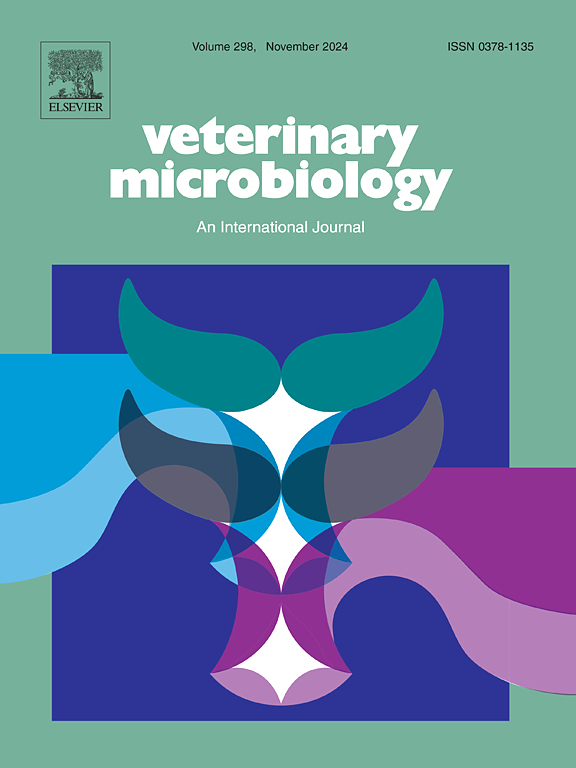重组沙门氏菌载体传递的3m2e -铁蛋白融合纳米颗粒对H9N2和H7N9禽流感病毒具有交叉保护作用
IF 2.7
2区 农林科学
Q3 MICROBIOLOGY
引用次数: 0
摘要
近年来,纳米医学的进步使疫苗开发领域发生了革命性的变化。许多基于纳米颗粒的纳米候选疫苗不断被开发出来。在此,我们描述了一种基于铁蛋白自组装纳米颗粒(NPs)的通用禽流感病毒候选疫苗。将与3M2e融合的铁蛋白通过重组沙门氏菌载体传递,形成新的重组菌株rSC0130(pYA3342-3M2eNPs)。3m2 -铁蛋白融合蛋白在重组菌株中高效表达并自组装成NPs。携带3m2 -铁蛋白融合NPs的重组菌株rSC0130(pYA3342-3M2eNPs)在体内诱导了针对AIV的特异性细胞和体液免疫应答,最终为鸡提供了有效的抗H9N2和H7N9禽流感病毒的交叉保护。我们的研究强调了沙门氏菌平台提供基于蛋白质的NPs的潜力,并为aiv通用疫苗的开发提供了新的见解。本文章由计算机程序翻译,如有差异,请以英文原文为准。
Recombinant Salmonella vector delivery 3M2e-ferritin fusion nanoparticles provide cross protection against H9N2 and H7N9 avian influenza viruses
In recent years, the advancement of nanomedicine has revolutionized the field of vaccine development. Numerous nanoparticle-based nano vaccine candidates have been continuously developed. Herein, we describe a universal avian influenza virus (AIV) vaccine candidate based on ferritin self-assembling nanoparticles (NPs). The ferritin fused with 3M2e was delivered by an recombinant Salmonella vector, resulting in the formation of a novel recombinant strain, rSC0130(pYA3342–3M2eNPs). The 3M2e-ferritin fusion protein was efficiently expressed and self-assembled into NPs within the recombinant strain. The delivery of the recombinant strain rSC0130(pYA3342–3M2eNPs), which carries the 3M2e-ferritin fusion NPs, induced robust specific cellular and humoral immune responses against AIV in vivo, ultimately providing chickens with effective cross-protection against challenges from H9N2 and H7N9 avian influenza viruses. Our study underscores the potential of the Salmonella platform for delivering protein-based NPs and offers new insights into the development of universal vaccines for AIVs.
求助全文
通过发布文献求助,成功后即可免费获取论文全文。
去求助
来源期刊

Veterinary microbiology
农林科学-兽医学
CiteScore
5.90
自引率
6.10%
发文量
221
审稿时长
52 days
期刊介绍:
Veterinary Microbiology is concerned with microbial (bacterial, fungal, viral) diseases of domesticated vertebrate animals (livestock, companion animals, fur-bearing animals, game, poultry, fish) that supply food, other useful products or companionship. In addition, Microbial diseases of wild animals living in captivity, or as members of the feral fauna will also be considered if the infections are of interest because of their interrelation with humans (zoonoses) and/or domestic animals. Studies of antimicrobial resistance are also included, provided that the results represent a substantial advance in knowledge. Authors are strongly encouraged to read - prior to submission - the Editorials (''Scope or cope'' and ''Scope or cope II'') published previously in the journal. The Editors reserve the right to suggest submission to another journal for those papers which they feel would be more appropriate for consideration by that journal.
Original research papers of high quality and novelty on aspects of control, host response, molecular biology, pathogenesis, prevention, and treatment of microbial diseases of animals are published. Papers dealing primarily with immunology, epidemiology, molecular biology and antiviral or microbial agents will only be considered if they demonstrate a clear impact on a disease. Papers focusing solely on diagnostic techniques (such as another PCR protocol or ELISA) will not be published - focus should be on a microorganism and not on a particular technique. Papers only reporting microbial sequences, transcriptomics data, or proteomics data will not be considered unless the results represent a substantial advance in knowledge.
Drug trial papers will be considered if they have general application or significance. Papers on the identification of microorganisms will also be considered, but detailed taxonomic studies do not fall within the scope of the journal. Case reports will not be published, unless they have general application or contain novel aspects. Papers of geographically limited interest, which repeat what had been established elsewhere will not be considered. The readership of the journal is global.
 求助内容:
求助内容: 应助结果提醒方式:
应助结果提醒方式:


